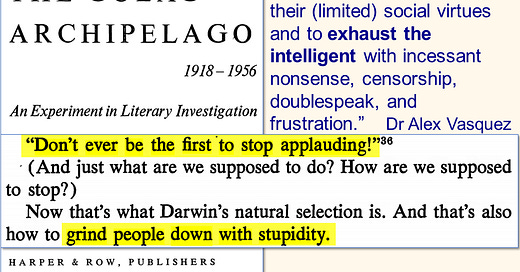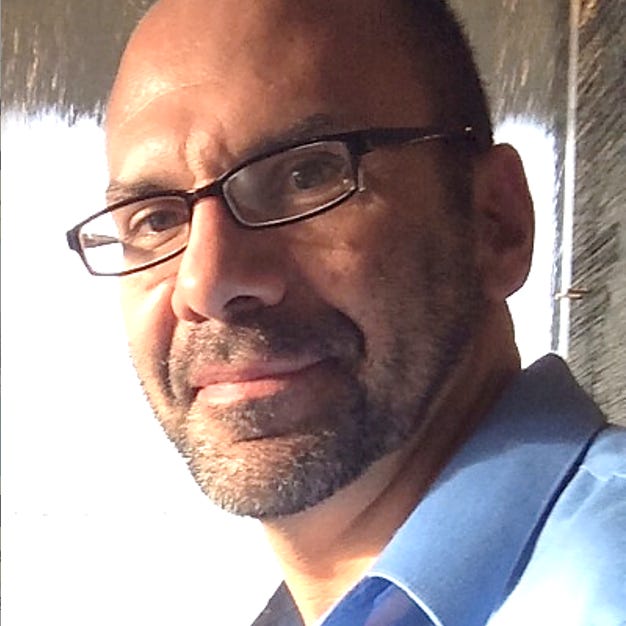Appreciating 4 levels of Brilliance in GULAG ARCHIPELAGO
"...how to grind people down with stupidity" from Solzhenitsyn's masterpiece Volume 1
I hit the nail on the head (if I may say so) with my recent comparison of proPharma censorship with the Gulag Archipelago because both of these systems impose crazy-making arbitrary censorship, penalization, and disappearance—either physical assassination or digitized character assassination, respectively. Furthermore, the ultimate motivation for both of these programs is identical: to grind people down with relentless stupidity/nonsense so that eventually they give up, withdrawal from the social-political realm and then let the small but powerful hordes of political manipulators run the world as fits their psychopathic and profiteering desires.
“The narrative of the Pandemic Theater is designed to target the masses with coercion and the hijacking of their (limited) social virtues and to exhaust the intelligent with incessant nonsense, censorship, doublespeak, and frustration.”
In a recent post, I wrote that LinkedIn—with its blatant pro-pharma censorship and violation of people’s basic rights to communicate—functions as the digital version of the Gulag Archipelago, imposing arbitrary censorship, penalization, and disappearance.
In this current post, I’ll provide a 4-level appreciation of Solzhenitsyn's masterpiece GULAG ARCHIPELAGO*
*widely available in book, audiobook, and PDF versions—see my previous post for immediate access to the PDF and audio versions; I recently purchased Volume 1 from audiobookstore.com.
After Amazon banned my Antiviral Nutrition book and deleted my previous personal purchases of digital books and audiobooks which I had paid for and accumulated for many years, I obviously learned that Amazon is a petty and vindictive shop-owner. I will not buy digital books from Amazon nor its Kindle or Audible platforms because they have stolen my purchases while keeping my money; for audiobooks, I now use audiobookstore.com because they allow customers to download the files of their purchases (thereby blocking Amazon-style retroactive thievery).
1. Contrast, artistic paradox, “tension of the opposites”
Whether you access the book in print or audio or both, a reader can’t help but notice the paradox of the author’s levelheadedness and eloquence while discussing absolute insanity and inhumane brutality. The writing is beautiful, and the audiobook version linked above is spectacular and lucid in its oration. It is simultaneously a historical documentary, social commentary, artwork of language and—in the whole—a delicious piece of brain candy. If you can experience eloquent articulation as a form of digital-audio music, then you will certainly love this written-spoken masterpiece.
The extreme brilliance of Solzhenitsyn's GULAG ARCHIPELAGO is particularly noted in his manifest ability to endure torture, starvation, false condemnation, and forced labor while mentally recording and distilling the collective experience of national psychopathy into an articulate, witty, honest and almost/mildly humorous three-volume archive, which rightly won him international acclaim.
“Holding the tension of the opposites” was a phrase popularized by Jungian psychotherapist Marion Woodman although the phrase itself came from a 1954 interview with Dr Carl Jung. Basically, the dynamic describes any state of mental and emotional tension experienced through holding simultaneous and extremely conflicting views, weather in politics, relationships or any other aspect of life. The extreme brilliance of Solzhenitsyn's GULAG ARCHIPELAGO is particularly noted in his manifest ability to endure torture, starvation, false condemnation, and forced labor while mentally recording and distilling the collective experience of national psychopathy into an articulate, witty, honest and almost/mildly humorous three-volume archive, which rightly won him international acclaim. You can imagine Solzhenitsyn being pulled to the left and right by strong forces as if in a tug-of-war between internal brilliance and external insanity and how he mastered that tension to produce a brilliant and enduring piece of political-social-humanistic literature.
2. Psychopathology of Stalin and Lenin
At another level of appreciation, you can see how the psychopathology of Stalin and Lenin permeated the entire country; sadistic bureaucracy trickled down and infiltrated every aspect of daily life for the Russian people. You can see how an entire country was traumatized and tortured psychologically through the arbitrariness and sheer brutality and scope of this hidden system of incarceration, exile and assassination/elimination. Up to 24 million people were imprisoned or killed within the secret system of prisons and forced labor camps (gulags) which were scattered across Russian territory in a way that resembled islands scattered across a sea (archipelago). During one particular year, after 5% of the entire Russian population was imprisoned: “1937-1938: Great Terror: one in every twenty people in Soviet Union arrested”
3. Creating an entire population of secondary psychopaths
I started studying Psychology and Sociology in my early 20s purely from intellectual interest and not necessarily for many personal or strategic need. However just a few years later in my mid-20s, I became very aware that I needed to learn more about people and the “games people play” in order to survive the bureaucracy of the graduate program that I started in 1996. You can see some of my earlier posts related to Psychology and psychopathy/sociopathy:
One of the topics that really fascinates me but on which I have never written or spoken is that of “secondary psychopathy” as well as “secondary genius.” The way that these terms are commonly used and understood implies that psychopathy and genius are both inherent, primary, possibly genetic attributes of the individual which are separate from their environment. In fact, the official definition of psychopathy is that it is primary, innate, from birth, and specifically differentiated from sociopathy which is always considered to be secondary and a consequence of a traumatic or deprived environment. This distinction can be easily remembered by observing that psychopathy and primary both start with P whereas sociopathy and secondary both start with the letter S.
When you observe examples of the human flourishing that occurred during the Italian Renaissance, what you’re observing are clear examples of genius and secondary genius which could only flourish with the time and financial support provided by philanthropists such as the Medici family. My interpretation of this is that we could live the Italian Renaissance every day for the eternity of human existence if we simply provided people time and means to be creative and artistic. Further, many apparently “normal” people could be creative geniuses in art, music, engineering, science, medicine and every other discipline if we liberated them from their retarding environments and gave them a bit of hope, inspiration and creative space. Our modern environments produce an abundance of human redundancy not because humans are inherently flawed but because our environments are flawed – or more specifically – designed to create a retarded version of humanity.* Although we might be able to formulate an argument stating that the creative people who gave form to the Italian Renaissance were specifically gifted within a specifically gifted genetic and geographical population, I think the more reasonable argument is that these talents lay dormant within the bulk of humanity and can be aroused to flourish with simple social nurturing.
*See my mention of JT Gatto’s work Dumbing Us Down in “INTELLECTUAL TECHNIQUES and TOOLS that will immediately change and empower the way you interact with the world”
What is clearly documented in Gulag Archipelago is that an entire society can become dominated and staffed by a large population of secondary psychopaths who flourish within and are groomed by an overarching psychopathic governance. These abusive enforcers clearly behaved as if they were primary psychopaths, but the truth is most of them probably were not primary psychopaths but were rather forced to behave and were empowered to behave in ways consistent with psychopathy and sociopathy.
Population-wide crimes against humanity (eg, Nazi-Jewish Holocaust, Russian gulags, Franco’s 40 years of fascist Spain, American-Indonesian slaughter of East Timor) are not passive occurrences, but rather they are constructed events with a specific structure— simply that of sadistic/profiteering leadership which enables, protects, and rewards a secondary subservient class of enforcers of criminality and brutality. We see the same structure in our plandemic bureaucracy. When we change our perspective of these events from that of passive occurrences to constructed events then, by extension, we can see that these events can be deconstructed, the leaders can be removed from power and punished and the bureaucratic structures can be dismantled and legally blocked from recurrence. Until we come to that understanding and until we take those actions, then we leave ourselves vulnerable to repeating these events. We can look at events like the Holocaust and repeat slogans like “never again” and “never forget” but we actually have to understand them and take effective physical/structured/legal action to prevent these events from happening to us now and to our descendants in the future.
4. The critical importance of pattern recognition when dealing with crimes against humanity
Iconic tragedy blinds us to daily tragedy. If we study the iconic and historical crimes against humanity as occurrences rather than as constructed events, then we will fail to see how these events are created, man-made, and sustained by simple structures. If you observe any and all crimes against humanity, they were created by a small group of sadistic psychopaths (commonly with a single iconic leader) who rewarded a larger group of enforcers who then paid systems of surveillance and propaganda to subdue populations of hundreds of millions of people.
Once we understand the structure of anything, we can then imagine its reversal and deconstruction and therefore its prevention. You’ll see that this is exactly the strategy that I use when dealing with clinical disease as discussed in my book Inflammation Mastery.







